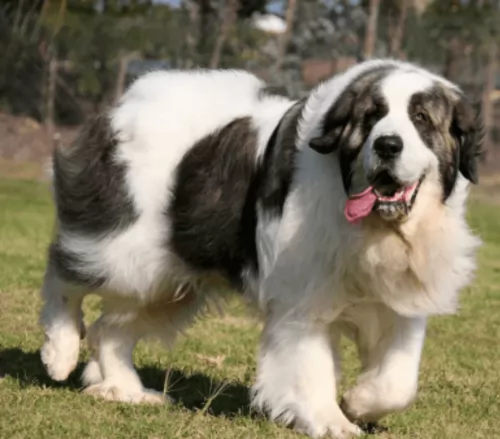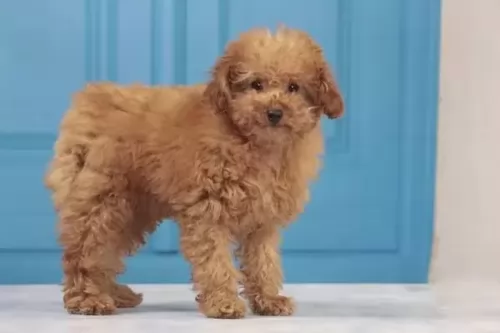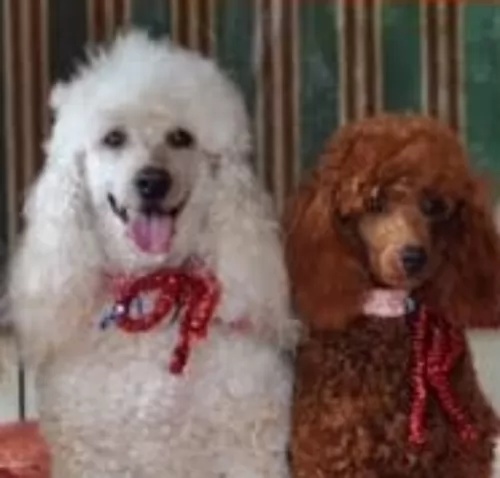 MyDogBreeds
MyDogBreeds Pyrenean Mastiff is originated from Spain but Miniature Poodle is originated from Germany. Pyrenean Mastiff may grow 44 cm / 18 inches higher than Miniature Poodle. Pyrenean Mastiff may weigh 92 kg / 203 pounds more than Miniature Poodle. Both Pyrenean Mastiff and Miniature Poodle has almost same life span. Pyrenean Mastiff may have more litter size than Miniature Poodle. Pyrenean Mastiff requires Low maintenance. But Miniature Poodle requires Moderate maintenance
Pyrenean Mastiff is originated from Spain but Miniature Poodle is originated from Germany. Pyrenean Mastiff may grow 44 cm / 18 inches higher than Miniature Poodle. Pyrenean Mastiff may weigh 92 kg / 203 pounds more than Miniature Poodle. Both Pyrenean Mastiff and Miniature Poodle has almost same life span. Pyrenean Mastiff may have more litter size than Miniature Poodle. Pyrenean Mastiff requires Low maintenance. But Miniature Poodle requires Moderate maintenance
 The Pyrenean Mastiff originates from Spain, descending from ancient livestock guardian-type dogs.
The Pyrenean Mastiff originates from Spain, descending from ancient livestock guardian-type dogs.
They have always been used as guardians, looking out for livestock and warding off predators.
When you do research you find that there is little information on the exact origins of the dog. It was only in recent years that the dog was taken out of its native region and sent to the USA, but it isn’t recognized by the AKC.
The dog was however recognized by the FCI in 1982.
 The Poodle is no stranger to the dog world and has been a familiar face in Western Europe for hundreds of years. Though they have lived in Europe for centuries, their origins are unsure, with some saying they hail from Germany and others say France.
The Poodle is no stranger to the dog world and has been a familiar face in Western Europe for hundreds of years. Though they have lived in Europe for centuries, their origins are unsure, with some saying they hail from Germany and others say France.
The Miniature Poodles have been used in both countries as gundogs for water birds.
They have always been admired for their intelligence, and Miniature Poodles are believed to have been bred from Standard Poodles. It is interesting to note the 3 official sizes of the Poodle are Toy, Miniature and Standard – all considered one breed and judged according to the same written standard, just with different size requirements.
 This is a beautiful big dog, strong and muscular. He stands at between 75 and 82cm in height and weighs between 70 and 100kg, males and females.
This is a beautiful big dog, strong and muscular. He stands at between 75 and 82cm in height and weighs between 70 and 100kg, males and females.
He has a thick double coat which is fairly long and which also sheds regularly. The coat is essentially white in color with large markings of reddish brown, tan, grey or black.
The Pyrenean Mastiff has a large head with a black nose, small, dark eyes, floppy, medium sized ears and a long tail with lush hair growth.
Large he may be, but the Pyrenean Mastiff is a docile dog that gets on well with children as well as with other pets. He is intelligent but also strong willed and independent, making him a little bit difficult to handle if he chooses to ignore your commands.
Training and socialization will be required if you want him to be obedient and well mannered. He can do well with you as a novice pet owner, so long as you are firm, consistent, kind, patient and fair in your handling of the Pyrenean Mastiff.
Even with socialization, he tends to be wary around strangers and becomes quite protective around his human family.
He is a calm dog that doesn’t require a whole lot of exercise, but he isn’t suited to life on a small property in the city as he needs a lot of space to feel content and at ease.
 With good care the lifespan of the Miniature Poodle is 14 – 16 years of age. This purebreed dog is small, standing at 28 – 38cm in height and weighing 7 – 8kg.
With good care the lifespan of the Miniature Poodle is 14 – 16 years of age. This purebreed dog is small, standing at 28 – 38cm in height and weighing 7 – 8kg.
The coat is typically curly, springy and dense. Colors of the coat can be cream, beige, silver, black, brown or apricot. They are low shedding dogs and are regarded as being hypoallergenic. The ears are floppy and the tail is usually docked to give the dog a nice, compact look.
The Miniature Poodle is intelligent and learns easily, so you won’t have any trouble with training him and having him socialized.
He is a lively dog and loves a game and a walk, loving as much time as possible spent with his human family. He gets on well with other pets in the home as well as with children who have been taught to be kind and gentle with animals.
They are not overly-friendly with strangers, and therefore make excellent watchdogs. They’re the kind of dogs who need both physical and mental stimulation though, and he won’t be content to be left and ignored – after all he counts himself as a member of your family! They make wonderful pets, being playful and energetic and loving water, always ready to swim with you.
 These beautiful dogs have always been extraordinary guarding dogs, but he has some other excellent characteristics that make him such a great companion.
These beautiful dogs have always been extraordinary guarding dogs, but he has some other excellent characteristics that make him such a great companion.
He is a loyal, loving dog and easy to train.
You just have to think twice before you take such a large dog into your home, as he doesn’t like to be cooped up in small spaces. He will also eat a lot too.
You want to know that you can provide the Pyrenean Mastiff with all these things. If you have the means to keep such a large pet, then he will make you a splendid canine companion.
 When you take a Miniature Poodle into your home and your heart, there are many wonderful positive aspects that come with him.
When you take a Miniature Poodle into your home and your heart, there are many wonderful positive aspects that come with him.
You won’t have any trouble training him as he is clever and bright. He is such a loving, loyal pet and he takes his job of guarding you seriously too.
Because they aren’t aggressive, they're easy to keep in the city or the countryside, so long as he receives plenty of love, companionship and exercise. Perhaps the only thing that may require a little bit of effort on your part is the fact that his coat will require quite a bit of upkeep to keep it looking good and healthy.
In exchange for looking after him, you’re going to benefit from having a wonderful canine friend and family pet in your life for many years.
 This is a fairly healthy dog breed, particularly when you consider what a big dog he is. There are always some health concerns to watch for so that you can take steps to get your pet well again.
This is a fairly healthy dog breed, particularly when you consider what a big dog he is. There are always some health concerns to watch for so that you can take steps to get your pet well again.
There is tartar build-up on the teeth and this can lead to infection of the gums and roots of the teeth. Rotting teeth can cause pain, but more worrisome they can cause damage to the heart and kidneys as well as the dog's joints. The vet or professional pet groomers can keep your pet’s teeth clean. They can advise you on how to take care of your large pet’s teeth.
Diseases such as rabies and parvo can be prevented by means of vaccine.
You can’t afford for a big dog like this to become obese. It’s a serious disease and can put pressure on your dog’s joints and also cause back pain and digestive disorders.
Your dog can be infected with all kinds of worms and bugs such as ticks d and fleas as well as mites. Some of these parasites can be transmitted to you. Your vet can talk about preventive medication.
Gastric Dilatation and Volvulus, commonly referred to as bloat often occurs in dogs with deep chests.
The stomach twists and fills with gas,and blood to the stomach is cut off. Left unattended to, your dog can die, sometimes within half an hour. His stomach is hard and swollen, requiring immediate veterinary attention.
 Dog’s thrive on good nutrition and exercise, and if your Miniature Poodle gets both of these combined with plenty of love, he can live to be up to 16 years of age and even older.
Dog’s thrive on good nutrition and exercise, and if your Miniature Poodle gets both of these combined with plenty of love, he can live to be up to 16 years of age and even older.
They are robust little dogs, but even so, they can get sick. Ear infections, joint diseases, obesity, dental disease and bloat are common dog diseases to look out for -
This is a life-threatening condition where your pet’s stomach fills with gas. The swollen stomach puts pressure on the diaphragm and the dog battles to breathe. The dog could also vomit, be drooling and lethargic.
The stomach can also twist putting the dog in shock. This bloating can occur with any dog breed and efforts can be made to avoid it by feeding the dog smaller more frequent meals as opposed to one larger meal which he gobbles up.
The dog shouldn’t exercise immediately after a meal either. You also want to avoid obesity at all costs.
When the mitral valve malfunctions, blood isn’t being pumped out of the heart to the rest of the body. If the mitral valve weakens or leaks it can lead to endocarditis.
Quite a number of dogs develop some form of heart disease during their lifetime, with a high percentage being due to mitral valve insufficiency, which is more common in smaller dogs.
Your dog may have a cough, be lethargic and lose weight. The first signs of a leaking mitral valve is a heart murmur. At first MVI doesn’t have obvious clinical signs, but with time the efficiency of the heart is reduced and congestive heart failure develops. Your veterinarian will evaluate your pet and suggest treatment.
A skin problem sounds fairly mild but it can cause havoc in your pet’s life, causing him to be constantly licking and scratching himself. The hair becomes dull and brittle, and breaking the skin from continuous scratching invites bacterial infection. These skin infections will require veterinary intervention.
 Have your pet spayed or neutered if you don’t want puppies. Spaying or neutering also decreases the likelihood of certain types of cancers.
Have your pet spayed or neutered if you don’t want puppies. Spaying or neutering also decreases the likelihood of certain types of cancers.
Nothing but a top quality diet is good enough for your pet. Commercially manufactured dog foods are a convenient means to feed your pet, and there are some excellent brands.
Look out for the ones for extra large dogs and avoid the ones with low quality ingredients. The dry kibble you give your big pet can be made more tasty when you add some homemade food to it about twice a week.
Dogs thrive on simplicity, so boiled chicken, sweet potatoes, brown rice or pasta, carrots and spinach will be wonderful for him when you chop the food up and add it into the dry kibble. Its such a tasty, wholesome treat for your pet.
Some raw meat added in occasionally will contribute to your pet’s heath. Make sure he is never without a constant supply of fresh, cool water.
Brush his coat at least twice a week. Check inside his ears for redness which could indicate an ear infection.
He’s an intelligent pet with lots of energy, so you will need to keep his mind and body active by ensuring he enjoys walks every day. He isn’t a dog that requires running with you on your jogs or cycles.
 If you opt to keep your Miniature Poodle’s coat long, it will actually require regular brushing – every day in fact, if you want to avoid matting and tangling. Most people don’t like the work this involves and they have their Poodle’s hair cut short all over, then he only needs a brush once or twice a week. Your Miniature Poodle just loves the time you spend with him grooming him. It’s your time to feel for any unusual lumps and to also check for fleas and ticks. Some people take their pet to the doggy parlor to have the coat clipped.
If you opt to keep your Miniature Poodle’s coat long, it will actually require regular brushing – every day in fact, if you want to avoid matting and tangling. Most people don’t like the work this involves and they have their Poodle’s hair cut short all over, then he only needs a brush once or twice a week. Your Miniature Poodle just loves the time you spend with him grooming him. It’s your time to feel for any unusual lumps and to also check for fleas and ticks. Some people take their pet to the doggy parlor to have the coat clipped.
The dog’s nails should also be trimmed regularly, and their ears also need to be checked for wax buildup and debris which can lead to an ear infection.
Teeth need to be checked over too because dental disease won’t only lead to loss of teeth but it could be toxic for important body organs too.
Wipe around your pet’s eyes as tear stains can form under the eyes.
Make sure to feed your pet a top quality diet full of vitamins and minerals. Get to know the foods which can be toxic for your pet and cause stomach upsets. Dogs appreciate simplicity and consistency with their diets, and apart from dry kibble, home-made food such as boiled chicken, brown rice and vegetables can be excellent for your pet.